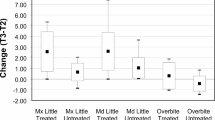Abstract
Data sources
PubMed and Cochrane Library electronic databases were searched from 1966 to January 2005. Reference lists of the relevant studies were searched by hand.
Study selection
For inclusion, articles had to satisfy the following criteria: have a follow-up period of at least 5 years post-retention; report on randomised clinical trials (RCT), prospective or retrospective clinical controlled studies or on cohort studies; and investigate orthodontic treatment including fixed or removable appliances, selective grinding or extractions.
Data extraction and synthesis
Screening of eligible studies, data extraction and assessment of methodological quality was conducted independently and in duplicate. The level of evidence of the included studies was graded as high, moderate or low according to predetermined criteria.
Results
The search strategy resulted in 1004 abstracts or full-text articles, of which 38 met the inclusion criteria. Treatment of crowding resulted in successful dental alignment but the mandibular arch length and intercanine width gradually decreased, and crowding of the lower anterior teeth reoccurred post-retention. This condition was unpredictable at the individual level. Treatment of Angle class-II division-1 malocclusion with a Herbst appliance normalised the occlusion. Relapse occurred but could not be predicted at the individual level. The scientific evidence was insufficient to draw conclusions about treatment of cross-bite, angle class III, open-bite and various other malocclusions, or about long-term patient satisfaction.
Conclusions
Despite a large number of studies on long-term stability after orthodontic treatment, this systematic review shows that evidence-based conclusions are few. This is mostly because of inherent problems with retrospective and inferior study design. There is a great need for well-designed prospective studies with untreated control groups; sufficient sample sizes; and sample selection according to type of malocclusion, age and growth pattern.
Similar content being viewed by others
Log in or create a free account to read this content
Gain free access to this article, as well as selected content from this journal and more on nature.com
or
References
O'Brien K, Wright J, Conboy F, et al. Effectiveness of treatment for class II malocclusion with the Herbst or twin-block appliances: a randomized, controlled trial. Am J Orthod Dentofacial Orthop 2003; 124:128–137.
Author information
Authors and Affiliations
Additional information
Address for correspondence: Lars Bondemark, Faculty of Odontology, Malmö University, Department of Orthodontics, Cal Gustavs väg 34, Malmö, Scania SE-20506 Malmö, Sweden. E-mail: lars.bondemark@od.mah.se
Bondemark L, Holm AK, Hansen K, et al. Long-term stability of orthodontic treatment and patient satisfaction. Angle Orthod 2007; 77:181–191
Rights and permissions
About this article
Cite this article
O'Neill, J. Long-term stability after orthodontic treatment remains inconclusive. Evid Based Dent 8, 81–82 (2007). https://doi.org/10.1038/sj.ebd.6400511
Published:
Issue date:
DOI: https://doi.org/10.1038/sj.ebd.6400511



